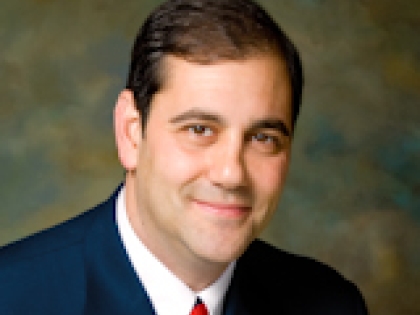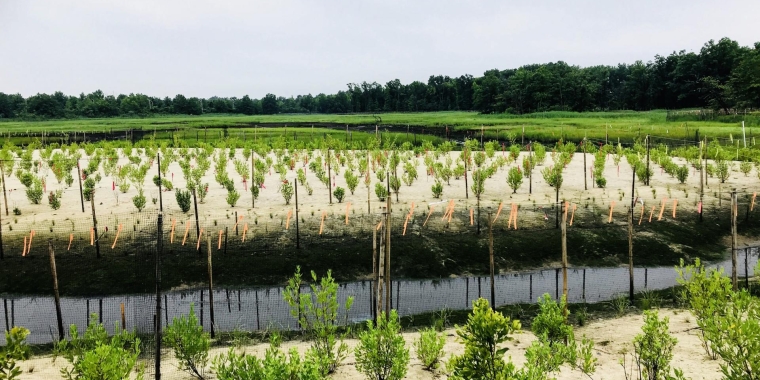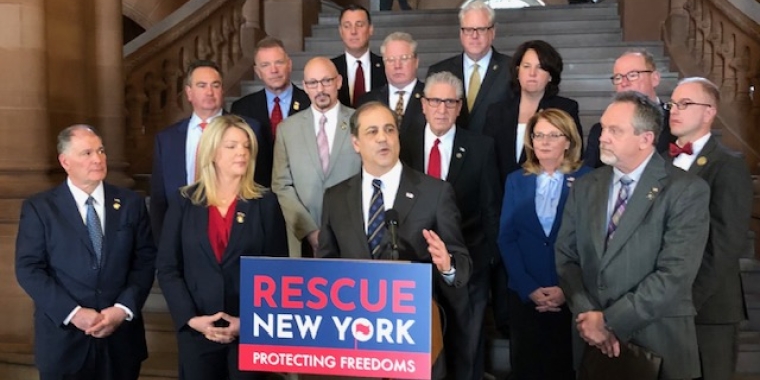
NYCEDC Announces Restoration Completion of 54 Acres of Wetlands in Staten Island Through First-of-Its Kind Mitigation Bank Program
October 15, 2019
-
ISSUE:
- Wetlands

The Saw Mill Creek restoration project has given new life to more than 50 acres of wetlands. After years of diligent planning by NYCEDC, Saw Mill Creek will provide both short and long term benefits for this community by establishing a working wetland area that will better protect the surrounding community from future storms.
Innovative program removed 40,000 cubic yards of debris and contaminated sediments from damaged coastline while reducing time, cost and environmental footprint of new shoreline investments

STATEN ISLAND, NY — New York City Economic Development Corporation (NYCEDC) announced the last planting of the 54 acres restoration of degraded wetlands on Staten Island’s West Shore. The wetland was successfully restored through the Saw Mill Creek Mitigation Bank pilot program, a first-of-its-kind program in New York City. Mitigation banking provides the opportunity to use public-private financing to fund large-scale restoration of wetlands while fostering ecologically responsible waterfront construction.
Located next to the West Shore Industrial Business Improvement District, Saw Mill Creek is a natural area between the West Shore Expressway and the Arthur Kill. The wetland suffered severe damage from historic dumping and from Hurricane Sandy undermining the site’s ecological function. Through this restoration project, which broke ground in 2017, more than 40,000 cubic yards of debris were removed from tidal wetlands, marshlands and mudflats that make up the Saw Mill Creek watershed, creating a net increase of 24 acres of wetlands.
“NYCEDC is proud to deliver the Saw Mill Creek Mitigation Bank project, which has been successful in restoring and protecting Staten Island’s valuable wetlands,” said NYCEDC President and CEO James Patchett. “This program proves that innovative approaches to wetland restoration and coastal development are not only effective, but vital to our city’s resiliency efforts. I’d like to thank New York City Parks, the State’s Department of Conservation and Regional Economic Development Grant Councils, the U.S. Army Corps of Engineers, the Hudson River Foundation’s Harbor Estuary Program, the Waterfront Alliance and our community partners for championing this effort and who helped make this project possible.
"Salt marshes are ecologically and historically significant to New York City,” said NYC Parks Commissioner Mitchell J. Silver, FAICP. “The restoration of Saw Mill Creek Marsh and establishment of the mitigation bank will improve water quality, provide a healthy habitat for wildlife and revitalize the city’s waterfront. We are grateful to NYCEDC for leading this project and our partners at the city, state and federal levels of government for their commitment to creating a more resilient city.”
Federal and state laws require developers, infrastructure builders and property owners seeking to develop or repair waterfront property to undertake restoration projects to mitigate the potential harm to waterway ecosystems. In a dense urban environment like New York City, finding acceptable sites for individual projects to offset construction impacts is difficult and can add years for construction and permitting. Mitigation banking streamlines the restoration process, allowing project sponsors across multiple sites to buy credits from an approved bank and support the restoration of a larger piece of land, rather than seeking regulatory approval for individual, smaller mitigation projects. Mitigation banking such as the project at Saw Mill Creek represents economies of scale, and ecologies of scale, and represents the regulatory preferred form or mitigating impacts to wetlands.
The credits generated through the Saw Mill Creek pilot program have been made available to public and private developers of waterfront properties in Staten Island, Manhattan, the Bronx and portions of the Brooklyn/Queens waterfront to ensure that their projects avoided and minimized environmental impact. Credits are now supporting project permitting for maritime businesses and needed coastal resiliency investments. In the aftermath of Hurricane Sandy, the de Blasio Administration prioritized wetland restoration as a key component of the City’s rebuilding and resiliency efforts.
“The Saw Mill Creek Wetland project is proof that we can take care of the environment in a way that is good for business and that will protect us against future storms,” said U.S. Congressman Max Rose. “When we use every tool at our disposal to protect ourselves from future storms – from creative new ideas like this mitigation bank on the West Shore to the Seawall on the East Shore, that’s a win-win for Staten Island.”
"The Saw Mill Creek restoration project has given new life to more than 50 acres of wetlands," said State Senator Andrew Lanza. "After years of diligent planning by NYCEDC, Saw Mill Creek will provide both short and long term benefits for this community by establishing a working wetland area that will better protect the surrounding community from future storms."
"Today's last planting ceremony is a welcome sign that Staten Islanders are working together to advance environmentally responsible goals,” said Assemblymember Michael Cusick. “Wetlands help protect our island from severe weather events, improve our quality of life by purifying the air, and create habitats for other species to live in. In the past, these ecosystems were seen as a nuisance that made development more difficult and expensive; today we understand that wetlands are a critical part of our city that support healthy lifestyles and sustainable growth. I look forward to seeing the success of the Saw Mill Creek Mitigation Bank replicated elsewhere in the city and across New York State."
“I am grateful to see the complete restoration of these acres of wetlands on our West Shore through the Saw Mill Creek Mitigation Bank program. The beauty of this project is that it enhances our island’s wetlands, which can reduce flooding and protect our shorelines from storm surges, while also allowing for proper future development along our West Shore,” said Borough President James Oddo.
“The restoration of Saw Mill Creek provides a great benefit to Staten Island, both environmentally and economically,” said Minority Leader Steven Matteo. “The innovative Saw Mill Creek Wetlands Mitigation Bank will make it easier, faster and ultimately less expensive for those who want to build and invest in our borough.”
“Our wetlands are an environmental asset, a delicately balanced ecosystem that fosters biodiversity and resiliency forming a protective barrier from storms,” said Council Member Debi Rose. “When I was chair of the City Council's Waterfronts Committee, I convened a hearing and tour of the Saw Mill Creek Marsh, where former wetlands had been filled, tidal flows obstructed and substantial areas overrun with invasive weeds. I am pleased to see the successful completion of this pilot program, which leveraged public and private investment through a first-of-its-kind mitigation bank to remove debris and restore a healthy ecosystem. I thank all of our partners who have worked together on this innovative project here on Staten Island to not only restore a crucial ecosystem but also demonstrate that this approach can be replicated elsewhere.”
"The Saw Mill Creek Mitigation Bank is an innovative way to allow waterfront construction to go forward while fostering wetland revitalization at the same time," said Roland Lewis, President and CEO of the Waterfront Alliance. "In two short years, since opening for business in 2017, this mitigation bank has proved to be a breakthrough win-win for the maritime industry and the environment, while, not insignificantly, greatly enhancing Staten Island's resilience. We applaud NYCEDC for this creative initiative."
NYCEDC will continue to accept applications to purchase whole or fractions of credits from the Saw Mill Creek Pilot Wetland Mitigation bank through August 25, 2021.
Interested parties can apply through the Saw Mill Creek Wetland Mitigation Bank RFP.
About NYCEDC
New York City Economic Development Corporation creates shared prosperity across New York City’s five boroughs by strengthening neighborhoods and creating good jobs. NYCEDC works with and for communities to provide them with the resources they need to thrive, and we invest in projects that increase sustainability, support job growth, develop talent, and spark innovation to strengthen the City’s competitive advantage. To learn more about our work and initiatives, please visit us on Facebook, Twitter, or Instagram.
Share this Article or Press Release
Newsroom
Go to Newsroom
Senator Lanza Unveils Vision For A More Free New York
March 28, 2023


